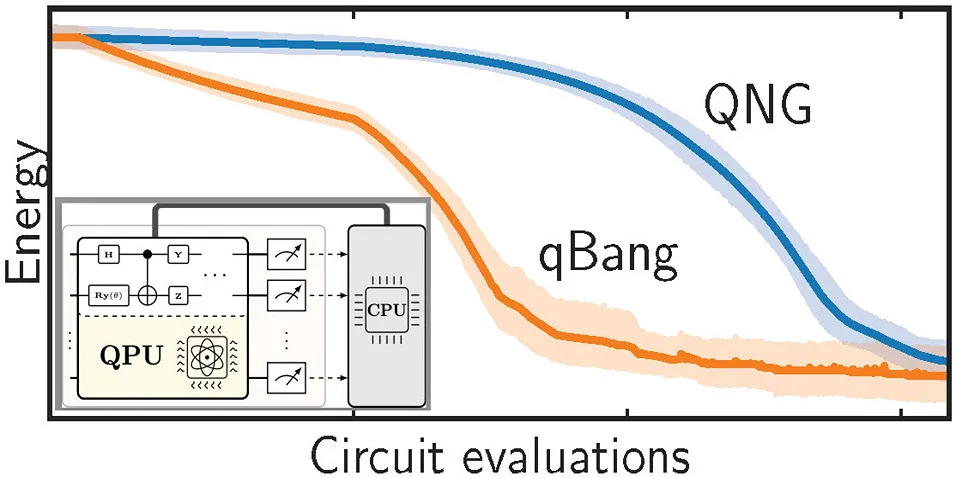Researchers from Chalmers University of Technology, Volvo Group Trucks Technology, and Future Technologies Saab Surveillance have proposed a new optimizer for Variational Quantum Algorithms (VQAs) called the quantum Broyden adaptive natural gradient (qBang) approach. VQAs are a promising method for utilizing quantum computing infrastructures, but their optimization can be slow and resource-intensive. The qBang approach combines the Broyden method with a momentum-based algorithm, reducing quantum resource requirements and performing better than more resource-demanding alternatives. This development could significantly improve the efficiency and effectiveness of VQAs, a crucial step in advancing quantum computing.
What are Variational Quantum Algorithms (VQAs) and their Optimization Challenges?
Variational Quantum Algorithms (VQAs) are a promising approach to utilizing current quantum computing infrastructures. They are based on a parameterized quantum circuit optimized in a closed loop via a classical algorithm. This hybrid approach reduces the quantum processing unit load but comes at the cost of a classical optimization that can feature a flat energy landscape.
VQAs represent a significant step forward in quantum computing, but they also present unique challenges. One of the most significant is the optimization of the algorithms themselves. The optimization process can be slow and resource-intensive, placing a significant burden on the quantum device. Existing optimization techniques, including imaginary time-propagation, natural gradient, or momentum-based approaches, are promising but often suffer from slow convergence.
The optimization process for VQAs is further complicated by the nature of quantum mechanics. As the system size grows, the associated Hilbert space grows exponentially. This complexity can result in gradients that decrease exponentially with increasing system size, a feature known as a barren plateau, making parametrized quantum circuits prone to poor convergence.
What is the Quantum Broyden Adaptive Natural Gradient (qBang) Approach?
In response to these challenges, a team of researchers from the Department of Microtechnology and Nanoscience at Chalmers University of Technology, Volvo Group Trucks Technology, Future Technologies Saab Surveillance, and the Department of Chemistry and Chemical Engineering at Chalmers University of Technology have proposed a novel optimizer called the quantum Broyden adaptive natural gradient (qBang) approach.
The qBang approach aims to distill the best aspects of existing approaches. It employs the Broyden approach to approximate updates in the Fisher information matrix and combines it with a momentum-based algorithm. This combination reduces quantum resource requirements while performing better than more resource-demanding alternatives.
How Does qBang Improve Upon Existing Techniques?
The qBang approach introduces a new development strategy for gradient-based VQAs. It offers several improvements over existing techniques. For one, it reduces the quantum resource requirements, making it a more efficient option. It also performs better than more resource-demanding alternatives, offering a clear improvement over existing techniques in the case of flat but not exponentially flat optimization landscapes.
The qBang approach also requires fewer function evaluations than other methods. After initialization, qBang requires only Onθ evaluations, yet shows considerable performance gain over QNG Adam and even quantum imaginary time evolution (QITE) on flat optimization landscapes.
What are the Practical Implications of the qBang Approach?
The practical implications of the qBang approach are significant. The availability of optimization strategies that provide reliable predictions with as few evaluations as possible on the Quantum Processing Unit (QPU) is crucial for the practical use of VQAs. The qBang approach meets this need, offering an optimization strategy that augments the reliable momentum-based optimization Adam with an efficient update of the local metric based on the QFIM using the Broyden method.
The qBang approach also offers a plethora of possible improvements for gradient-based VQAs. It represents a promising development in the field of quantum computing, offering a more efficient and effective way to optimize VQAs. As quantum computing continues to advance, approaches like qBang will be crucial in maximizing the potential of this powerful technology.
Publication details: “Optimizing Variational Quantum Algorithms with qBang: Efficiently Interweaving Metric and Momentum to Navigate Flat Energy Landscapes”
Publication Date: 2024-04-09
Authors: David Fitzek, Robert S. Jonsson, Werner Dobrautz, Christian Schäfer, et al.
Source: Quantum
DOI: https://doi.org/10.22331/q-2024-04-09-1313

